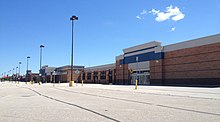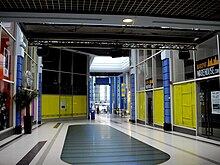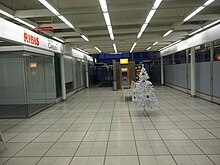Dead mall


Adead mall,[1]also known as aghost mall,zombie mallorabandoned mall,is ashopping mallwith low consumer traffic level or isdeterioratingin some manner.[2]
Many malls inNorth Americaare considered "dead" when they have no survivinganchor storeor successor that could attract people to the mall. Without the pedestrian traffic that department stores previously generated, sales volumes decline for almost all stores and rental revenues from those stores can no longer sustain the costly maintenance of the malls.[3][4]
Changes in the retail climate[edit]
Structural changes in the department-store industry have also made survival of these malls difficult. These changes have contributed to some areas or suburbs having insufficient traditional department stores to fill all the existing larger-lease-areaanchor spaces.A few large national chains have replaced many local and regional chains, and some national chains are defunct.

In theUSandCanada,newer "big box"chains (also referred to as" category killers ") such asWalmart,TargetCorporation andBest Buynormally prefer purpose-built free-standing buildings rather than using mall-anchor spaces.[5]21st-century retailing trends favor open airlifestyle centers;which resemble elements ofpower centers,big box stores, and strip malls; and (most disruptively for storefronts)online shoppingover indoor malls.[6]The massive change ledNewsweekto declare the indoor mall format obsolete in 2008.[7]The year 2007 marked the first time since the 1950s that no new malls were built in the United States.[5]Most Canadian malls still remain indoors after renovations due to the harsh winter climate throughout most of the country, however theDon Mills Centrewas turned into an open-air shopping plaza. Attitudes about malls have also been changing. With changing priorities, people have less time to spend driving to and strolling through malls and, during theGreat Recession,specialty stores offered what many shoppers saw as useless luxuries they could no longer afford. In this respect, big box stores and conventional strip malls have a time-saving advantage.[8]

The number of dead malls has increased significantly because the economic health of malls across the United States has been in decline, with high vacancy rates in many of these malls.[9]From 2006 to 2010, the percentage of malls that are considered to be "dying" by real estate experts (have a vacancy rate of at least 40%), unhealthy (20–40%), or in trouble (10-20%) all increased greatly, and these high vacancy rates only partially decreased from 2010 to 2014.[9]In 2014, nearly 3% of all malls in the United States were considered to be "dying" (40% or higher vacancy rates) and nearly one-fifth of all malls had vacancy rates considered "troubling" (10% or higher).[9]

Some real estate experts say the "fundamental problem" is a glut of malls in many parts of the country creating a market that is "extremely over-retailed".[9]Cowen Research reported that the number of malls in the U.S. grew more than twice as fast as the population between 1970 and 2015; Cowen also reported that shopping center "gross leasable area" in the U.S. is 40 percent more shopping space per capita than Canada and five times more than the U.K.[10]
Some malls have maintained profitability, particularly in areas with frequent inclement weather (or otherwise weather undesirable for outdoor activities, such as shopping in an open-air shopping/lifestyle center)[citation needed]or large populations of senior citizens who can partake inmall walking.[11]Combined with lower rents, these factors have led to companies likeSimon Mallsenjoying high profits and occupancy averages of 92%.[12]Some retailers have also begun to re-evaluate the mall environment, a positive sign for the industry.[13]
Aretail apocalypsethat started in the 2010s made the dead mall situation even more noticeable, due to the complete closing of several retailers, as well as anchor tenantsMacy'sandJCPenneyclosing many locations and the sharp decline inSears Holdings.The trend was particularly noticeable whenPittsburgh Mills,a mall once worth as much as $190 million, was sold at aforeclosuresale for $100, with the mall itself being purchased bylienholderWells Fargo.[14][15]
Demographic change[edit]
It has been suggested that some malls die when the surrounding neighborhoods undergo ademographic changeorsocio-economic decline.[5]
History[edit]
COVID-19 pandemic[edit]
The COVID-19 pandemic exacerbated many issues affecting malls.[16]During theCOVID-19pandemic, many malls closed temporarily due tostay-at-home orders.[17][18]A number of notable retailers filed for bankruptcy during the pandemic includingAscena Retail Group,Brooks Brothers,GNC,JCPenney,Lord & Taylor,andNeiman Marcus.
North American malls that have permanently closed citing the pandemic as a precipitating factor includeNorthgate Mallin Durham, North Carolina,Cascade Mallin Burlington, Washington, and theMetrocenterin Phoenix, Arizona.
Redevelopment[edit]
Dead malls are occasionally redeveloped. Leasing or management companies may change the architecture, layout, decor, or other component of a shopping center to attract more renters and draw more profits. Several dead malls have been significantly renovated into open-air shopping centers.[19]
Redevelopment can involve a switch from retail usage to office or educational use for a building, such as is the case withEastgate MetroplexinTulsa, Oklahoma,[20]Park Central MallinPhoenix,Eastmont Town CenterinOakland, California,Windsor Park MallinSan Antonio(now the global headquarters ofRackspace),Global Mall at the CrossingsinNashville, Tennessee,and theCoral Springs Mallin Florida. Allegheny Center Mall, a retail mall just north of downtownPittsburgh,Pennsylvania,closed as a retail mall in the early 1990s. The mall was redeveloped into office space with much of the space taken by telecommunications carriers,data centeroperators, andInternet service providers,and is now a majorcarrier hotelserving southwestern Pennsylvania. Another use for a former mall can be seen inLexington, Kentucky,whereLexington Mallwas partially demolished and converted into asatellite worship centerfor alocal megachurch.
Conversion from a shopping mall into an open-air, mixed-use area may entail the demolition of parts of or all of the former shopping mall. An example of this can be seen inFairfax County, Virginia,where the old Springfield Mall was converted intoSpringfield Town Center,amixed-use developmentthat includes a 12-screen movie theatre, shops, and restaurants with outdoor seating and entrances. When the structures are demolished completely, it is known as agreyfield site.In jurisdictions such asVermont(with a strict permitting process) or in major urban areas (where open fields are long gone), this greyfielding can be much easier and cheaper than building on agreenfield site.An example of this type of redevelopment isPrestonwood Town CenterinDallasandVoorhees Town CenterinVoorhees Township,New Jersey.Also, inBoardman, Ohio,theSouthern Park Mall,demolished the formerSearsbuilding, to construct DeBartolo Commons.[21]The commons honors lateEdward J. DeBartolo Sr.
Amazon,FedEx,DHL,UPSand theUnited States Postal Servicehave already acquired the sites of some failed malls and converted them to fulfillment centers.[22]A proposal called "Re-Habit"[23]uses portions of struggling malls, particularly vacated big box space, for homeless housing.[24]As an example of this concept, the vacantMacy'sin theLandmark MallofAlexandria, Virginia,has been converted into a temporary homeless shelter[25]for the Carpenter's Shelter.[26]
Some major healthcare systems such as Vanderbilt Health and the University of Rochester (UR) Health have converted several dying malls into new "health malls" or "mall to medicine". The large spaces allow for the easy conversion of space-intensive activities such as ambulatory surgical centers, while the multiple storefronts facilitate "one stop shopping" for all of health related needs. Roughly half of100 Oaks Mallin Nashville, TN is now dedicated toVanderbilt University Medical Center.[27]Following the model, it is expanding to other dead or dying malls throughout its region,[28]whileUniversity of Rochester Medical Centeris converting roughly one-third ofThe Marketplace Mallin Henrietta, NY.[29]
Notable dead malls[edit]
Open with high vacancy rates[edit]
- Bonnie Doon Shopping Centre, Edmonton, Alberta, Canada
- Circle Centre Mall, Downtown Indianapolis, Indiana
- Crystal Mall, Waterford, Connecticut
- East Hills Mall, Saint Joseph, Missouri
- Edmonton City Centre Mall, Edmonton, Alberta
- Embarcadero Center, San Francisco, California
- Exton Square Mall, Exton, Pennsylvania
- Frontenac Mall,Kingston, Ontario
- Galleria at Pittsburgh Mills, Tarentum, Pennsylvania
- Greenspoint Mall, Houston, Texas
- Hagerstown Premium Outlets, Hagerstown, Maryland
- Lloyd Center, Portland, Oregon
- Market Square Shopping Centre, Geelong, Australia
- Midway Mall, Elyria, Ohio
- Neshaminy Mall, Bensalem, Pennsylvania
- New Horizon Mall, Balzac, Alberta
- Northgate Centre, Edmonton, Alberta
- The Orchards Mall, Benton Township, Michigan
- Orlando Fashion Square, Orlando, Florida
- Playground Pier, Atlantic City, New Jersey(formerly Pier Shops at Caesars Palace)
- Prizm Outlets, Primm, Nevada(formerly Primm Outlet Mall)
- Puente Hills Mall, Puente Hills, California
- Riverview Crossing, Edmonton, Alberta(formerly Abbottsfield Shoppers Mall)
- Signal Hill Mall, Statesville, North Carolina
- South China Mall, Dongguan, China(formerly New South China Mall; occupancy has recovered after renovations in 2018[30]
- Uptown, Brisbane, Australia
- Voorhees Town Center, Voorhees Township, New Jersey
- Westmount Centre, Edmonton, Alberta
- Westmount Mall, London, Ontario
- Wintergarden, Brisbane, Australia
- Wiregrass Commons Mall, Dothan, Alabama
- Carré Göttingen, Germany
Abandoned[edit]
- Century III Mall, West Mifflin, Pennsylvania
- Chambersburg Mall, Chambersburg, Pennsylvania
- Forest Fair Village, Cincinnati, Ohio(formerly Forest Fair Mall, The Shops at Forest Fair, Cincinnati Mills, Cincinnati Mall)
- Gwinnett Place Mall, Duluth, Georgia
- Hamilton Eaton Centre, Hamilton, Ontario
- Hawthorne Plaza, Hawthorne, California
- Lakeforest Mall, Gaithersburg, Maryland
- Lakeside Mall, Sterling Heights, Michigan(awaiting planned demolition and redevelopment)
- Military Circle Mall, Norfolk, Virginia
- Northridge Mall, Milwaukee, Wisconsin
- Powerplex STL, St. Louis, Missouri(formerly St. Louis Outlet Mall, St. Louis Mills)
- Rainbow Centre Factory Outlet, Niagara Falls, New York
- Shenango Valley Mall, Hermitage, Pennsylvania(closed recently, with its final anchor JCPenney shuttering on May 31st, 2024)
- Toombul Shopping Centre, Brisbane, Australia
Demolished or Redeveloped[edit]
- Carousel Mall, San Bernardino, California(formerly Central City Mall)
- Cary Towne Center, Cary, North Carolina
- Chapel Hill Mall, Akron, Ohio
- Columbus City Center, Columbus, Ohio
- Cottonwood Mall, Holladay, Utah
- Dixie Square Mall, Harvey, Illinois
- Eastfield Mall, Springfield, Massachusetts
- Eastgate Mall, Chattanooga, Tennessee
- Eastland Mall, Charlotte, North Carolina
- Eau Claire Market, Calgary, Alberta
- Euclid Square Mall, Euclid, Ohio
- Fiesta Mall, Mesa, Arizona
- Forest Mall, Fond du Lac, Wisconsin
- Harborplace, Baltimore, Maryland
- Heritage Mall, Edmonton, Alberta
- Jamestown Mall, Florissant, Missouri
- Knoxville Center, Knoxville, Tennessee(formerly East Towne Mall)
- Landmark Mall, Alexandria, Virginia
- Lincoln Mall, Matteson, Illinois
- Mall of the Bluffs, Council Bluffs, Iowa
- Niagara Square, Niagara Falls, Ontario
- Northland Center, Southfield, Michigan
- Northland Village Mall, Calgary, Alberta
- North Town Mall, Edmonton, Alberta
- Owings Mills Mall, Owings Mills, Maryland
- Randall Park Mall, North Randall, Ohio
- Richmond Town Square, Richmond Heights, Ohio
- Rolling Acres Mall, Akron, Ohio
- Silver City Galleria, Taunton, Massachusetts
- Summit Place Mall, Pontiac, Michigan
- Thornhill Square, Toronto, Ontario(hybrid office/shopping complex partially demolished for redevelopment for office expansion)
- Valley View Center, Dallas, Texas
- Westland Mall, Columbus, Ohio
See also[edit]
- Dan Bell— creator ofDead Malldocumentary series
- Jasper Mall– 2020 American documentary film
- Liminal space (aesthetic)– Internet aesthetic capturing empty places
- List of shopping malls in the United States
- Modern ruins
- Urban decay
Footnotes[edit]
- ^"Greyfields and Ghostboxes Evolving Real Estate Challenges".Uwex.edu. Archived fromthe originalon 2009-05-26.Retrieved2009-07-16.
- ^"Recession Turns Malls Into Ghost Towns - WSJ.com".Online.wsj.com. 2009-05-22.Archivedfrom the original on 2014-12-14.Retrieved2013-09-08.
- ^Rosenbloom, Stephanie (10 July 2009)."Malls See Plenty of Action, but Less of It Is Shopping".The New York Times.Archivedfrom the original on 2 September 2016.Retrieved24 February2017.
- ^Newman, Rick (2009-06-26)."How To Tell When a Mall Is In Trouble".News.yahoo.com.Retrieved2009-07-16.
- ^abcGlancey, Jonathan (2014-04-11)."The death of the US shopping mall".BBC.Archivedfrom the original on 2014-04-28.Retrieved2020-01-23.
- ^Greg Guenthner (2016-12-20)."Amazon is crushing shopping malls".Business Insider.Archivedfrom the original on 2017-12-01.Retrieved2017-05-09.
- ^Dokoupil, Tony (2008-11-12)."Is the American Shopping Mall Dead?".Newsweek.Archivedfrom the original on 2009-12-03.Retrieved2009-10-24.
- ^"The vanishing shopping mall".The Week. 2009-03-26.Archivedfrom the original on 2010-01-25.Retrieved2009-10-24.
- ^abcdSchwartz, Nelson D. (3 January 2015)."The Economics (and Nostalgia) of Dead Malls".The New York Times.Archivedfrom the original on 12 August 2017.Retrieved24 February2017.
- ^Thompson, Derek (10 April 2017)."What in the World Is Causing the Retail Meltdown of 2017?".The Atlantic.Archivedfrom the original on 10 April 2017.Retrieved10 April2017.
- ^"Mall Walking".Walking.about.com. 2013-07-17. Archived fromthe originalon 2013-05-08.Retrieved2013-09-08.
- ^Cory Schouten (11 December 2009)."General Growth deal would extend Simon's mall dominance | Indianapolis Business Journal".IBJ.com.Archivedfrom the original on 2012-11-12.Retrieved2013-09-08.
- ^Melissa Regennitter (2010-05-29)."Leading the charge to bring back the mall".Muscatinejournal.com.Archivedfrom the original on 2010-08-12.Retrieved2013-09-08.
- ^"Foreclosed mall once valued at $190M is auctioned for $100".WTOP.2017-01-18. Archived fromthe originalon 2017-01-26.Retrieved2017-01-19.
- ^Anderson, Tom (2017-01-21)."Entire Pittsburgh mall sells for $100—all 1.1 million square feet of it".CNBC.Archivedfrom the original on 2017-01-24.Retrieved2017-01-25.
- ^Maheshwari, Sapna (5 July 2020)."With Department Stores Disappearing, Malls Could Be Next".The New York Times.Archivedfrom the original on 19 August 2020.Retrieved19 August2020.
- ^"Chicago-area malls and stores shut down by COVID-19".WIFR-LD.March 18, 2020.Archivedfrom the original on December 22, 2021.RetrievedAugust 19,2020.
- ^"Mall of America reopens, with only 150 of 500 stores open Wednesday".Star Tribune.June 10, 2020.Archivedfrom the original on June 13, 2020.RetrievedAugust 19,2020.
- ^"Visions of the Future?".National Real Estate Investor.2003-05-01.Archivedfrom the original on 2020-02-05.Retrieved2020-02-05.
- ^Evatt, Robert (2016-02-18)."From Retail to Revamped: Eastgate Metroplex Fills Up Its Biggest Spaces".Tulsa World.Archivedfrom the original on 2019-07-22.Retrieved25 July2019.
- ^Medore, Josh (2019-09-07)."Southern Park Mall Rebuilds for Next 50 Years with DeBartolo Commons".Business Journal Daily | The Youngstown Publishing Company.Archivedfrom the original on 2022-12-14.Retrieved2023-05-24.
- ^Fung, Esther; Herrera, Sebastian (2020-08-09)."Amazon and mall operator look at turning Sears, JC Penney stores into fulfillment centers".The Wall Street Journal.Archivedfrom the original on 2020-08-10.Retrieved2020-08-09– via Fox Business.
- ^"Re-Habit KTGY Architecture + Planning".Archivedfrom the original on 2019-02-22.Retrieved2019-02-22.
- ^Goss, Joe (5 October 2018)."Efforts To House Homeless In Empty Big-Box Stores Move Forward".Forbes.Archivedfrom the original on 22 February 2019.Retrieved21 February2019.
- ^Hickman, Matt (29 August 2018)."Can vacant mall stores alleviate homelessness?".www.mnn.com.Mother Nature Network.Archivedfrom the original on 24 March 2019.Retrieved11 March2019.
- ^"Carpenter's Shelter About Page".Archivedfrom the original on 2018-06-28.Retrieved2019-03-12.
- ^Farmer, Blake (13 April 2022)."Mall-to-medicine transitions make health care more convenient for suburban patients".Market Place.Archivedfrom the original on 2022-08-29.Retrieved2022-08-29.
- ^McDonald, Hannah (24 March 2022)."VUMC wants to take mall-to-medicine concept to Antioch. It helped turn 100 Oaks Mall around".Archivedfrom the original on 2022-08-29.Retrieved2022-08-29.
- ^Kucko, Natalie (30 June 2022)."1 year later: UR making progress on orthopedic campus at Marketplace Mall".Archivedfrom the original on 2022-08-29.Retrieved2022-08-29.
- ^Lý, vị lai; trương, tuệ mẫn (2020-12-21)."Dịch tình chi hạ, hoa nam mall kiên trì cải tạo thăng cấp, tương trứ trọng đả tạo lĩnh nam đặc sắc nhai khu".www.163.com(in Chinese).Archivedfrom the original on 2023-10-06.Retrieved2023-09-19.
Further reading[edit]
- Christensen, Julia (2008).Big Box Reuse.MIT Press.ISBN978-0-262-03379-4.
- Simpson, Tim (2010). "Lazarus, the Dead Mall, and the Demise of the City Center". In Burd, Gene; Jassem, Harvey; Drucker, Susan J.; Gumpert, Gary (eds.).The Urban Communication Reader.Hampton Press. pp. 35–47.CiteSeerX10.1.1.718.7459.hdl:10692/20936.ISBN978-1-57273-948-2.
- Laura, Schatzman (22 August 2013).Metabolizing obsolescence: strategies for the dead mall(Thesis).hdl:2142/45379.
- Ferreira, Daniela; Paiva, Daniel (8 August 2017). "The death and life of shopping malls: an empirical investigation on the dead malls in Greater Lisbon".The International Review of Retail, Distribution and Consumer Research.27(4): 317–333.doi:10.1080/09593969.2017.1309564.S2CID168971868.
